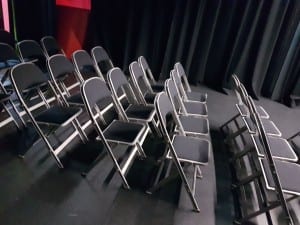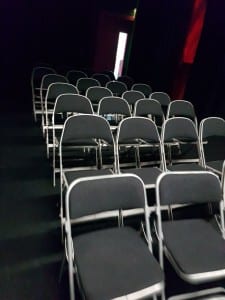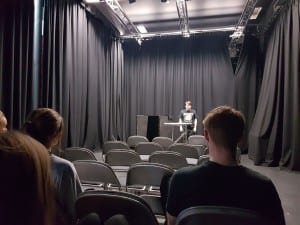So, on the 21st May, after months of hard work, sheer determination, three ideas and also a lot of rollercoaster POV’s, I performed my final degree show, The Ride of My Life – a show that focused on my childhood and the challenges I faced. Since performing it and having time to reflect on the show, I have decided to create this blog post to discuss my reflection on the module and how I felt not only the process has gone but also to discuss my own thoughts on the performance. However, in order to do this, I have decided to do this post as a set of viva-voce/ post-show discussion related questions since we do not have one for the module. So, without further ado, here are my thoughts.
1. What made you want to focus on a personal story
There are multiple reasons behind this and to be frank, this was not an idea that I originally had envisioned. Indeed, as you will see on my previous blog posts, my original idea was based on YouTube and the culture of Youtubing. However, in the case of this show, the reason why I wanted to do it was because I wanted to discuss something that not many people knew. Indeed, the majority of the audience did not know my story prior to seeing it and I felt that whilst it would have been interesting to have done a topical show, I wanted to bring a story together that actually would make people feel something. Plus, there is something authentic about my own story. Whilst I am not saying it has only happened to me and that there are not other people diagnosed with Worster-Drought Syndrome nor ADHD, the story I have encountered is a unique one and I wanted to highlight the uniqueness of the show by showing it in my own crafty manner that I would want to do without forcing an audience to feel something.
2. When devising the show, what challenges did you face?
A lot. In many ways, excluding the process to the other shows, the big problem I faced was I did not want the piece to feel self indulgent or manipulative as my worry was that whilst I can influence an audience on what they should feel, I cannot force them to feel that. If I did that, they would lose interest with the show at all. As the piece was focused on a personal story, I wanted them to feel engrossed with it and not feel like they were distanced to the show so that was a challenge.
Another thing that was a challenge was how to stage the show. Indeed, whilst I was aware the show would occur in Studio 2, I felt the staging had to feel right and so there was a seamless transition between the element of the rollercoaster and the personal story. So, by thinking carefully on the staging and also what the LPAC could offer, I was able to provide the right staging that would be simple to understand but also extremely impressive. In many ways, the challenge was less setting out the space as if it was a show but instead, trying to set it out as if the audience did not think that they were in Studio 2 at first.
But, the major challenge was cutting the script. Indeed, whilst I do believe that the show did have some punch and was clear, there was so much more that I could use to develop it into a longer show. Therefore, cutting the show was hard as I wanted to ensure that the show had enough depth and heart to it as it did have if it was a twenty minute piece.
3. In your opinion, how important is authenticity in a performance?
Personally, I think it is essential for the performance to have authenticity. Partly because by having authenticity in a show, it allows the audience to connect more with a performer and bring forward a bond between the audience and performer. As well, it allows the audience to be able to realise that what they say is honest and whilst this may be fictitious, they can establish this bond even more. So, from bringing in authenticity, it allows the performer to be closer to an audience and establish a relationship that is vital to the show.
4. How did you utilise authenticity in the show? Did you feel it was well utilised?
To ensure that the show felt authentic, I made sure that there were numerous things I did to utilise this. One way this was utilised was to ensure that I was never labelled as a different person in the show. Therefore, whilst I did take on multiple personas, it was in the style of Tim Crouch where I would be “Daniel Fotheringham as…” a ride attendant or Mrs. Arsehole or The Incredible Hulk. By doing this, it allowed the audience to not only distinguish character but gain a personal connection with myself as a performer and also as my characters.
Another way that the authenticity was utilised was in the beats of the script. Indeed, as I wanted the show to feel pure and like how it would sound as if I was saying the story to someone in a pub. Just without the artsy stuff. Indeed, as you can see in this segment from the script, I utilised this by mixing comedy and drama together by being able to give the audience a taster not just of the story but also of myself in real life:
The Script:
When searching for schools, my parents found “Kingstone High” – a school focused on performing arts. (The overture of Phantom of the Opera is heard. As this happens, the performer dresses up as the phantom and turns around ). Too dramatic? Once I made my decision to go there, I told my friends.
He turns round to certain audience members tears pictures of himself making confetti.
To get into the school, I had to get level fours in English, Maths and Science . My average – level twos. What do you think Mrs Arsehole?
V/O: You will not get level fours. But, I admire your effort. Good luck.
When I told my mum, she would do everything to help me.
Pause. The Performer sits down.
I wait patiently by the letterbox.
In doing this as well, I felt that this use of authenticity was well realised as I showed not only a glimpse into my life but the audience also got to understand the struggles I still go through. By showcasing this in the script, it helped me in the authenticity of the show by being myself in the script.
5. How did the audience receive the show? Did you intentions for the show work?
In doing the show, I set out to do a set of things. Firstly, I wanted to break the boundaries between theatre and performance by making something that was entertaining but different. Second, I wanted to make the audience feel something.
The following statement from a friend of mine here details their thoughts on the show:
“Congratulations! You pulled it off amazingly! Seeing the Tutor’s faces light up as well as my peers in the room as we were taken on our ride/performance was quite something! You should be proud of the performance, for teaching us so much about you, and for allowing us to celebrate your achievements with you in such a fun way!”
(Anonymous, 2018).
In being able to do the show, I felt not only the audience felt enticed but that they were genuinely keen to see where my performance would go next. Indeed, one of the things of performing the show was that the story is not one I have discussed that much to others. Therefore, by keeping a lot of the secrets under wrap, it allowed me to journey the audience through a “rollercoaster” of a show where they were they were unable to predict how it would end.
As well, some of the comments was overwhelming in which they said that they felt the show was pure and in no means, emotionally manipulative, and felt innocent. Therefore, it felt overwhelming as I set out to do something that was around the lines of this. If anything, I was overwhelmed by the feedback actually given to me.
What would you improve on if you were to redo the show?
If it was to be improved, there would be not much done. Aside from the possibility of adapting it into a thirty minute show that would go into more depth. Aside from minor things that went wrong, there would not be much that would be improved not because I am being arrogant but because I am happy with how this had been done. I am really satisfied with the way the final product. This module has been a pleasure doing and I am really satisfied with the way the show I have done.
With this post, I end my university education. Thank you to everyone who has helped with my project and the three years. Hopefully this will be not the end of this show. But, for now, its thank you and I hope you enjoyed “The Ride of My Life”







